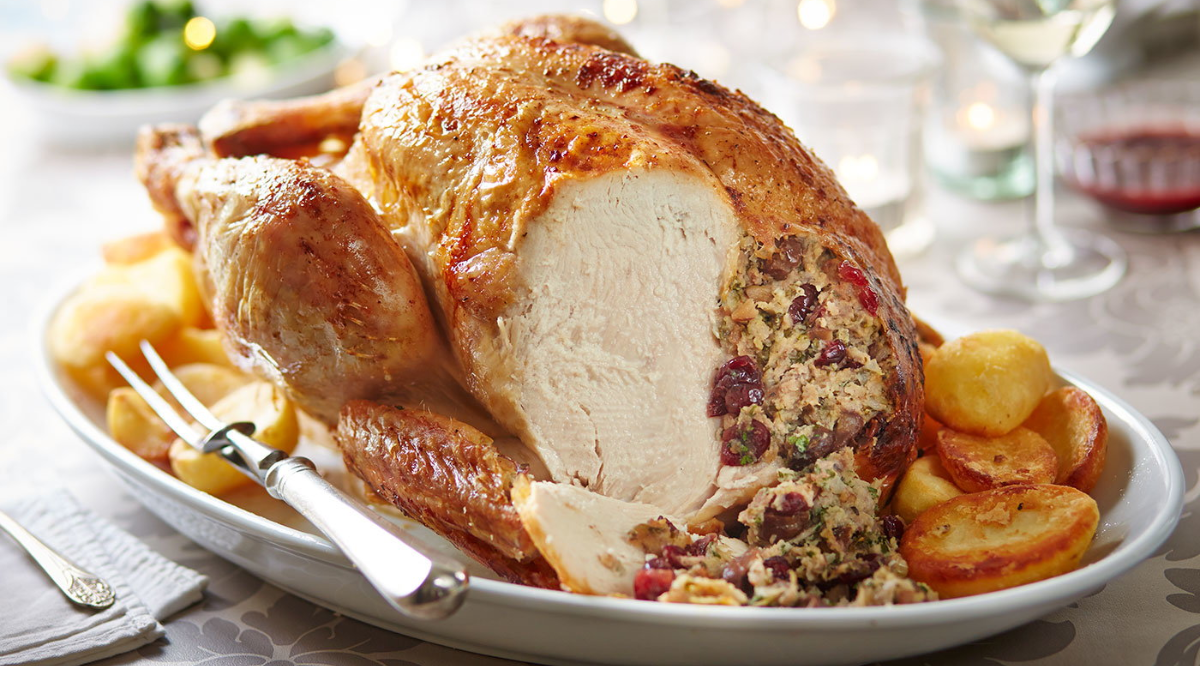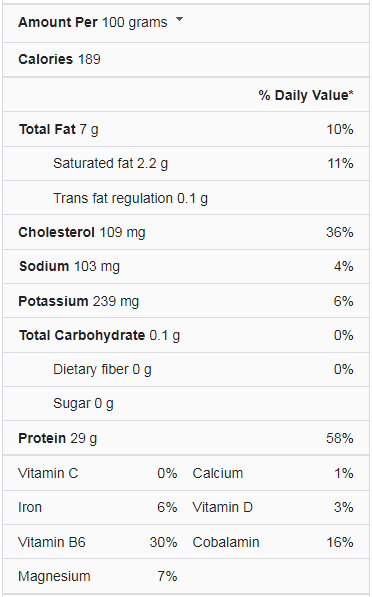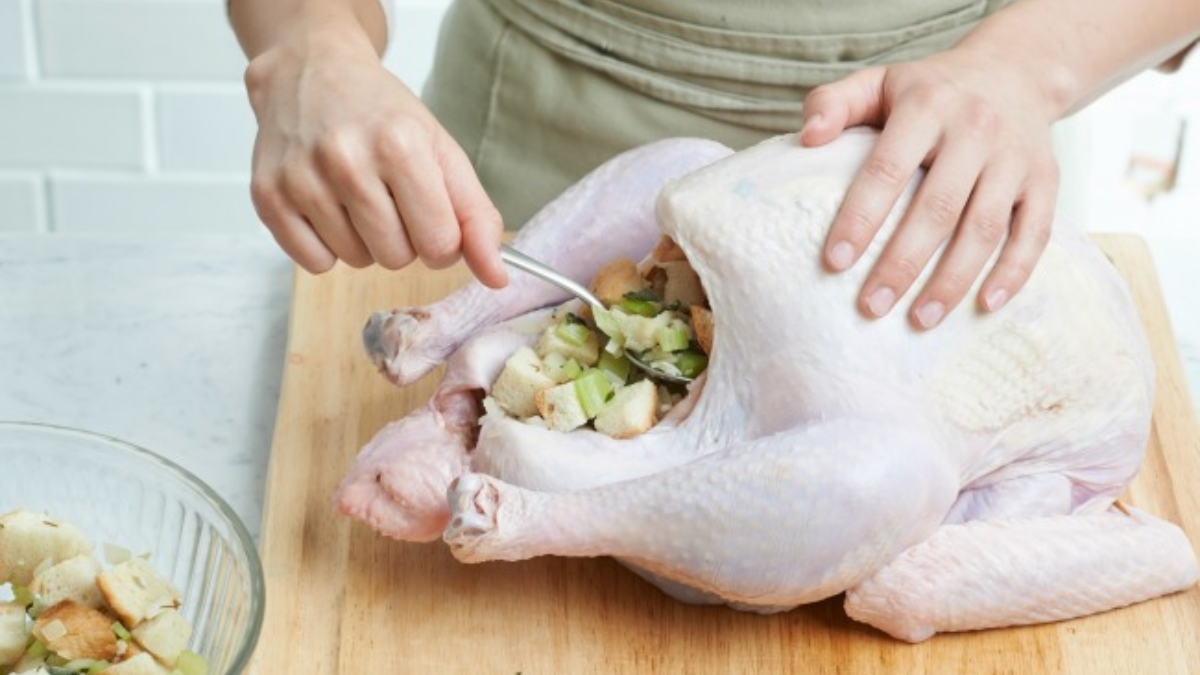A simple, uninteresting turkey won’t do for a Thanksgiving feast. A great stuffing that everyone will rave about all year long is one of the finest ways to make your nerve-wracking turkey roasting experience a success. Use a tasty, juicy, and thrilling mixture to give your bird the flavor it deserves and surpass the high expectations of your friends and family. The traditional focal point of many holiday tables is a beautifully roasted and stuffed turkey. But stuffing a turkey involves more than just stuffing a turkey.
Let’s discuss food safety briefly before we start stuffing. A turkey’s warm, moist inside is an ideal breeding ground for hazardous bacteria; therefore, food safety is a major concern when dealing with stuffing. The USDA advises home chefs to use a thermometer to check that the stuffing has reached 165 degrees F (75 degrees C) before serving, even if it disapproves of pre-stuffed turkeys produced by retailers and restaurants.
Turkey Nutrition Facts
What is Stuffing?
Around the Thanksgiving dinner table, anxious faces and rumbling tummies wait for the turkey and additional helpings of stuffing. A traditional favorite side dish for turkey feasts is stuffing, a concoction of chopped veggies, herbs, and bread crumbs. Also known as dressing, it is offered in a wide range of flavors, from fruit-infused to oyster-based to herb-flavored.
Nobody truly knows when or where stuffing first appeared. One widely known myth focuses on the initial cause: after being cleaned and gutted, wild game-like fowl cavities need something within to keep their shape. Before finding the combination of stale bread and chopped veggies, early cooks loaded their birds with whole vegetables. When the meat was finished cooking, the fluids from the flesh would flavor the breadcrumbs, creating a new meal.
Herbs, spices, finely chopped veggies, and breadcrumbs are combined to make stuffing. It can be cooked on the stovetop or as a roast within a bird’s cavity. Some recipes rely on actual pan drippings, whereas the majority of recipes require the inclusion of liquid, like chicken broth or stock.
How to Stuff Turkey?
Here are the steps to follow while stuffing turkey:
Remove the Giblets
Most uncooked turkeys have a small package that holds the bird’s gizzard, heart, and liver. Consider it a free flavor sack: The offal tastes great in dressing and gravy. Although it’s ideal for opening the container before cooking your turkey, it won’t significantly impact your health if you forget. Before stuffing the turkey, spread herb butter (also known as compound butter) under the skin to add more taste and moisture. After clipping loose pieces and removing the giblets, dry the inside and outside of the animal with a paper towel.
Stuff Turkey’s Neck Cavity
Put your stuffing in the neck cavity by spooning. Loosely stuff it, draw the skin over the filling, and use a metal skewer to secure it to the turkey’s back.
Stuff Turkey’s Body Cavity
Loosely spout your filling into the body cavity. You shouldn’t cram the stuffing firmly because it expands while cooking, resulting in a dense, sticky texture and incomplete cooking of the stuffing. Then truss your turkey’s legs. Roast the stuffed turkey as directed in the recipe. Insert the meat thermometer probe into the center of the stuffing to check that it has reached 165 degrees F (75 degrees C).
To Stuff or Not to Stuff
Traditional Christmas stuffing, according to some chefs, takes away from a turkey’s flavor because it takes longer to cook than the bird, perhaps resulting in dry meat. Cooking the dressing separately and then adding it to the cooked turkey while resting is a simple substitute.
Some chefs swear by cooking the stuffing inside the turkey because the juices from the bird flavor it. If you decide to bake your stuffing separately from the turkey, you can top it with some pan drippings before putting it in the oven.
Should we Stuff Turkey or Not?
It used to be standard practice to fill your turkey. Things have changed as people become more aware of foodborne illnesses and associated hazards. The good news is that you can stuff your turkey without risk.
The Issue
A decent-sized Thanksgiving turkey needs a few hours to cook in the oven. Not only for how long but also for what temperature the oven should be set. Your bird must cook to the right internal temperature to destroy any potentially dangerous bacteria (such as salmonella) hiding in the meat and its juices.
Salmonella outbreaks have previously been connected to stuffing a huge turkey. People weren’t roasting their turkeys for the recommended period or at the correct temperature. Additionally, overstuffing the turkey harmed the cooking because it is harder to destroy bacteria when a bird is overcrowded, which created a terrible combination. Even worse, if you remove stuffing from a turkey that hasn’t been cooked properly, it’s possible that the stuffing is tainted and unsafe to eat.
The Solution
The USDA advises purchasing frozen pre-stuffed turkeys since these birds go through inspection to ensure proper handling. But you shouldn’t thaw these turkeys; you should cook them straight from the freezer. The USDA strongly discourages consumers from purchasing fresh pre-stuffed turkeys since they are handled by numerous persons and are more likely to be contaminated.
How to Choose Right Turkey for Stuffing?
It can be challenging to select the ideal turkey for your celebrations. Here are a few pointers and essential tools to make planning even simpler.
Fresh vs. Frozen
According to the National Turkey Federation, there is no difference in quality between fresh and frozen turkeys. Both options offer advantages and disadvantages, but you can make the final decision. Fresh is a good choice if your freezer isn’t too big. The drawback is that you must purchase it because the refrigerator can only store it for a few days. Go for it if you can fit it and find a decent deal on a frozen bird! Although frozen birds can be stored for up to six months, remember to allow time for defrosting.
Defrosting a Frozen Bird
At least three days before when you intend to prepare it, remove the chicken from the freezer. Clear some space in the refrigerator and place the turkey on a tray to catch fluids that may leak out as it defrosts. A 20-pound turkey needs about three days to defrost properly; smaller birds can require less time. Running lukewarm water over your bird for a few hours will help it defrost if you forget to put it in the refrigerator in time, and it’s still somewhat frozen (not fully frozen).
Ensure the water isn’t hot, so the meat doesn’t start to cook. Many people leave their turkey on the countertop overnight to thaw more quickly after forgetting to defrost it until the day before Thanksgiving. Don’t! Bacteria can grow long enough to risk making your dinner guests ill (and you can forget about hosting next year).
Size
Size is one important aspect of a delectable bird. If you’re expecting a large crowd, you might want to purchase two smaller turkeys rather than one larger one because smaller turkeys are typically more delicate.
Estimate six ounces of raw beef per person; when cooked, this amount will drop to four ounces, which is the recommended serving size. Remember to factor in leftovers as well.
Calculate 6 ounces per person, for instance, if you’re serving supper to 10 people (10 x 6 = 60 ounces). If you want enough food for everyone to have leftovers for two meals, multiply that amount by three (60 x 3 = 180 ounces). If you want to round up, 180/16 equals 12 pounds when converting from ounces to pounds.
Cooking Time
Most people overlook that the time needed to roast a turkey depends on its weight. Whether you start with a fresh or frozen bird affects how long it takes to cook—plan to cook a defrosted turkey for 20 minutes per pound at 350 degrees Fahrenheit. The cooking time for fresh turkey is 10 to 15 minutes per pound. Therefore, roasting a fresh 12-pound turkey would take between 120 to 180 minutes (two to three hours); a frozen turkey of the same size would require 240 minutes (or four hours).
Is Stuffing Healthy?
The fact that stuffing isn’t the healthiest component of your Christmas or Thanksgiving meal surely doesn’t come as a surprise, but that doesn’t mean you should skip it. Stuffing can be produced from scratch or bought chilled, frozen, or dehydrated. It is often heavy in fat, carbohydrates, and salt.
The bird’s giblets were traditionally used in stuffing with sausage meat, bread as a source of starch, and certain aromatics like onion, herbs, and spices. The usage of giblets in stuffing recipes has decreased, and vegetarian stuffing recipes increasingly use dried fruit, nuts, and other items to give texture, flavor, and interest.
Shop-bought dehydrated items tend to be high in salt despite being lower in fat due to their major cereal foundation. Avoid adding any additional by rehydrating them with water rather than stock and baking with unsalted butter or vegetable oil.
Conclusion
Remove any giblets from your turkey before stuffing it, then season the bird inside and out. Then you can bake it with your preferred stuffing recipe for a delectable holiday feast! Some individuals are happy to prepare dressing as a separate meal, but others enjoy the Thanksgiving custom of stuffing the turkey before serving it to guests.
To avoid having a catastrophic Thanksgiving, there are a few crucial safety considerations you must keep in mind before stuffing your bird. Make sure your stuffing reaches a temperature of at least 165°F before serving to eliminate bacteria and pathogens, and give your turkey at least 20 minutes to rest before carving. To lower the risk of foodborne disease from bacteria that may be present in raw materials, the USDA advises precooking any raw meat, poultry, or seafood that will be used in your stuffing.
For an accurate reading, wait five minutes after inserting a heat-safe food thermometer through the middle of the bird so that the probe’s tip reaches the stuffing.
Make your stuffing and steer clear of pre-stuffed birds if you want to err on the side of caution because they increase the chance of bacterial growth and disease over time. It’s crucial to wait to stuff your bird until just before it’s ready to go into the oven to prevent cross-contamination. And to ensure that the air can flow while it cooks, you should always loosely fill the cavity.



